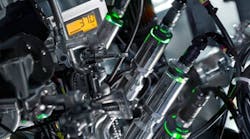Pharma facilities operate under tight controls to produce quality medications for the public. But the nature of manufacturing pharmaceuticals also introduces risks for employees. These facilities must find a balance between high production output and preventing accidents.
Fortunately, as technology and regulations advance, workwear keeps evolving to handle new risks. Using workwear designed specifically for the pharma industry setting allows companies to protect staff from workplace hazards while also complying with essential regulations related to contamination and risk.
Unique risks in pharma facilities
Danger takes many forms in pharma facilities. The potential for minor to serious employee injuries exists from chemical contact, operating equipment and repetitive motion.
A look at pharma incident reports shows some common accidents:
- Chemical splatters or spills burn skin or injure eyes
- Tripping or sliding on slick surfaces causes falls and related trauma
- Contact with hot surfaces like ovens brings burns
- Airborne particles irritate respiratory systems
- Cuts from sharp implements like glass or metal
- Inadequate protective equipment enables the contamination of sterile goods
How specialized workwear safeguards employees
Ergonomic workwear explicitly designed for pharmaceutical tasks helps avoid many common safety incidents. Special workwear makes a vital barrier against hazards and pollutants. Innovative fabric features prevent liquid contact, particle buildup and static. Meeting rigid safety rules, pharma workwear ensures regulatory compliance, too.
Companies can choose between various fabrics and designs including:
Chemical-resistant fabrics: Specially made fabrics resist permeation by dangerous chemicals. Coatings like Viton and polyethylene act as barriers, stopping chemicals from burning skin. Multi-layer materials add backup protection from major risks. Some standard chemical-resistant textiles are:
- Viton rubber: Repels fuels, oils and chemicals. Guards against splashes.
- Polyethylene: Repels particles, fluids, and biological threats. Used in hazmat suits or cleanrooms.
- Nomex: Won't burn. Protects against flash fires and heat.
Sealed seams: Bindings of tape seal all stitching. This prevents contamination threats from wicking through tiny needle holes along threads and coming in contact with the skin.
ESD clothing: Anti-static gear prevents static sparks. Also called electrostatic discharge (ESD) clothing, conductive fabrics avoid static buildup. In industries like pharma, where workers may handle explosives or flammable products, the risk of static-induced ignition is a real concern. ESD outfits serve as a protective measure by dissipating charges safely to the ground, effectively averting potential fires or blasts.
High visibility design: Retroreflective trim bounces light back to its source. Workers wearing these types of clothes are more visible in dim conditions. Paired with bright colors like yellow or orange, high-visibility clothing prevents struck-by accidents.
Ergonomic design: Special workwear also uses purposeful design features for safety:
- Unrestricted movement: Articulated knees and elbows made of stretch fabrics allow complete flexibility. This promotes comfort while preventing torn seams during activity. By maintaining mobility, ergonomic patterns lessen injury potential.
- Moisture wicking: Fabrics like polyester swiftly pull sweat outward, keeping workers dry. By whisking away sweat before it accumulates inside, the focus stays sharp.
- Well-fitted sizing: Tailored, contour-hugging workwear militates against loose material apt to catch in machinery. Optimal fits align to body dimensions without limiting movement, averting trip risks.
Aligning with safety standards and regulations
For workwear to reduce risks, it must meet governmental and industry safety standards. Pharma gear should satisfy quality benchmarks. It should comply with rules on preventing contamination. Training staff, managing hazards, and documentation are also part of the equation. Choosing proper workwear means regulatory compliance and staff safety.
For workwear to be considered safe and effective, it must meet established quality and testing benchmarks. There are several critical standards that quality pharmaceutical workwear should adhere to:
- ASTM permeability ratings
- ANSI visibility rules
- NFPA fire resistance edicts
- ISO cleanroom criteria
But even if workwear checks the box on these standards, that doesn't automatically mean it works like it should out in the real world. That's why independent testing by outside experts is so important.
These third-party labs take finished workwear and test it under conditions mimicking real life. For example, they'll expose fabrics to chemicals at concentrations workers might encounter and see how well they hold up over time. Or they'll simulate flash fires to gauge heat protection. They even test cleanroom gear to ensure almost zero particles that could contaminate pharmaceuticals get released.
Third-party testing confirms that what the workwear claims on its tag is actually legitimate. It provides profound reassurance that uniforms will perform their protective duties in workplace settings.
Another good practice is random batch testing. As production rolls along month after month, labs periodically pull some garments and verify they still meet all the safety criteria. This checks that the manufacturer hasn't started cutting any corners over time.
Special workwear also ensures that pharma facilities achieve safety regulations such as:
- OSHA rules on analyzing hazards and PPE
- GMP standards for preventing contamination
- Required documentation and risk management
Special workwear programs
To help pharma companies stay on track with workwear, third-party companies offer specialized workwear programs. These programs are tailored to the unique needs of a company’s business and employees.
Once leadership decides to use specialized workwear, the following critical steps should be taken:
- Extensive hazard evaluations: Check chemical, contamination and injury exposures based on tasks. Guides next actions.
- Proper workwear choices for exposures: Match protective qualities to assessed threats. Choose suitable fabrics, coatings, and designs to reduce risks.
- Training on usage, care, and maintenance: Educate staff on properly wearing, cleaning, storing, and replacing depleted gear. Ensures comprehending limitations and replacement cues.
- Replacement cycles: Set lifespans based on usage intensity to phase out depleted items early. Avoids shortages while refreshing worn items.
These steps decrease risks while supplying enough equipment.
When implementing new workwear programs, facilities commonly encounter hurdles such as:
- Budget constraints on new protective clothing. Prioritizing the highest-risk applications first is recommended.
- Achieving staff cooperation with garment use, cleaning, storage, and replacement guidance. Education assists adoption.
- Logistical challenges of ongoing workwear maintenance, repair, disposal, and replacement. Developing protocols promotes compliance.
- Monitor program success and revise based on hazard trends. Adjustments may be needed over time.
Focusing resources on a well-planned launch maximizes the workwear program's value for safety and compliance.
By methodically introducing industry-specific workwear, pharma organizations can overcome difficulties, creating sound safety programs focused on decreasing risks. The layered hazard protection keeps staff, products and facilities safe — even in hazardous places.






